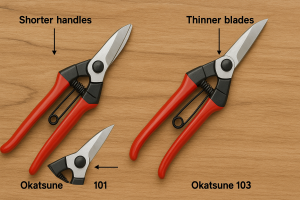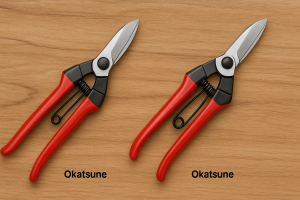Curious about the key differences between Okatsune 101 vs 103? While both models are part of Okatsune’s high-quality range of Japanese pruning shears, their differences make each uniquely suited for specific gardening tasks. Choosing the right pair can enhance precision, comfort, and efficiency in your pruning routine.
Okatsune shears are trusted by professional gardeners and bonsai enthusiasts alike for their sharp blades and ergonomic design.
However, subtle distinctions in size, weight, and intended use set the 101 and 103 models apart. Whether you’re working on small bonsai trees or larger branches, understanding these differences ensures you pick the perfect tool.
In this article, we explore the 10 most important differences between Okatsune 101 and Okatsune 103, comparing everything from dimensions and applications to hand comfort and control. By the end, you’ll know exactly which pair suits your pruning style.
What Is Okatsune 101?
The Okatsune 101 is a compact and lightweight pruning shear designed for smaller hands or precision work. It features a 55mm blade length and a total length of 180mm, making it easy to maneuver in tight spaces. The 101 is favored by bonsai growers and gardeners who need accuracy and control.
Its blades are made from Izumo Yasugi steel, a high-quality Japanese steel that retains sharpness longer than most. The design is simple but effective—no frills, just precision cutting performance. Its lightweight structure makes it less fatiguing for prolonged use.
The red and white handles offer both visual appeal and ergonomic comfort. It’s ideal for people who want a nimble tool that excels in finesse pruning. The spring-loaded design and smooth blade action make it feel effortless in small tasks.
Pros:
- Lightweight feel
- Precise cuts
- Ideal for bonsai
- Sharp Japanese steel
- Compact size
- Great for detail
- Less hand fatigue
Cons:
- Not for thick branches
- May feel small
- Less leverage
What Is Okatsune 103?
The Okatsune 103 is the full-size version, designed for general pruning tasks across a variety of plant types. With a 200mm overall length and 55mm blades, it offers more leverage and cutting power. This makes it ideal for thicker stems and heavier-duty pruning tasks.
Like the 101, it uses Izumo Yasugi steel, ensuring it stays sharp and resists rust. The build quality is equally high, making it a favorite among professional landscapers and home gardeners alike. Its robust nature doesn’t sacrifice the elegant simplicity of the tool.
The 103 fits comfortably in medium to large hands and provides a strong cutting grip without hand strain. It’s a perfect all-purpose pruner that combines strength with precision. You can expect years of reliable performance with minimal maintenance.
Pros:
- Strong cutting power
- High durability
- Full-sized handles
- Versatile use
- Ideal for pros
- Balanced weight
- Ergonomic grip
Cons:
- Too big for some
- Slightly heavier
- Less precision than 101
What Is The Difference Between Okatsune 101 And 103? Find 10 Best
1. Okatsune 101 vs 103 Size and Dimensions
Okatsune 101: The 101 is a compact model measuring approximately 180mm (7 inches) in length. It is ideal for users with smaller hands or for precise work in tight spaces, such as bonsai trimming or flower pruning.
Okatsune 103: The 103 is larger at about 200mm (7.8 inches), offering a longer blade and more leverage. This makes it better suited for cutting medium branches and general-purpose pruning.
Key Differences:
- Okatsune 101: Compact and precise
- Okatsune 103: Larger and more powerful
2. Okatsune 101 vs 103 Weight
Okatsune 101: Lighter than the 103, the 101 is easier to handle for delicate work or prolonged use. It’s favored by those who prefer a lighter tool for quick snips.
Okatsune 103: Heavier, offering more weight behind each cut. This added heft provides cutting power for thicker stems and branches.
Key Differences:
- Okatsune 101: Lightweight
- Okatsune 103: Heavier, more cutting power
3. Okatsune 101 vs 103 Blade Length
Okatsune 101: Features a shorter blade, roughly 45mm, ideal for precision pruning tasks.
Okatsune 103: Comes with a longer blade (approximately 55mm), allowing it to tackle thicker branches and cut more efficiently with each snip.
Key Differences:
- Okatsune 101: Short blade for accuracy
- Okatsune 103: Longer blade for broader cuts
4. Okatsune 101 vs 103 Intended Use
Okatsune 101: Best for detailed pruning, including bonsai, flowers, herbs, and delicate stems.
Okatsune 103: Designed for general garden use, such as pruning shrubs, roses, and woody stems.
Key Differences:
- Okatsune 101: Precision work
- Okatsune 103: General pruning
5. Okatsune 101 vs 103 Grip and Comfort
Okatsune 101: Its smaller size suits users with small hands and allows greater maneuverability in tight spots.
Okatsune 103: Provides a fuller grip, ideal for medium to large hands. Less suitable for those with smaller hands or arthritis.
Key Differences:
- Okatsune 101: Best for small hands
- Okatsune 103: Better for larger hands
6. Okatsune 101 vs 103 Cutting Capacity
Okatsune 101: Best suited for soft, green stems up to 10mm in diameter.
Okatsune 103: Can handle tougher stems and branches up to 15mm, thanks to its sturdier construction and larger blades.
Key Differences:
- Okatsune 101: Smaller cutting capacity
- Okatsune 103: Handles thicker branches
7. Okatsune 101 vs 103 Portability
Okatsune 101: Easier to carry in a pocket or tool pouch. Preferred for fieldwork and mobile tasks.
Okatsune 103: Bulkier and may require a holster. More suitable for stationary garden work.
Key Differences:
- Okatsune 101: Highly portable
- Okatsune 103: Less portable
8. Okatsune 101 vs 103 Price and Value
Okatsune 101: Slightly cheaper, making it a good entry-level option for those focused on precision.
Okatsune 103: Priced a bit higher due to its size and cutting capacity, offering excellent value for general gardening.
Key Differences:
- Okatsune 101: Affordable, focused use
- Okatsune 103: Higher value for versatility
9. Okatsune 101 vs 103 Durability
Okatsune 101: Durable but intended for lighter tasks. Less suitable for hard or woody stems.
Okatsune 103: Built to withstand frequent, heavy-duty pruning. Stronger blades and handle.
Key Differences:
- Okatsune 101: Durable for light work
- Okatsune 103: Heavy-duty construction
10. Okatsune 101 vs 103 Professional Use
Okatsune 101: Favored by florists, bonsai artists, and hobby gardeners needing precision.
Okatsune 103: Used by professional landscapers and gardeners for all-purpose tasks.
Key Differences:
- Okatsune 101: Niche professional use
- Okatsune 103: Broad professional appeal
Okatsune 101 vs 103 – Key Differences
One of the main differences is size—101 is smaller and lighter, while 103 is full-sized and heavier. The 101 is 180mm in total length and suited for small hands, whereas the 103 is 200mm and better for medium to large hands. Both share the same blade material and cutting edge quality.
Another key difference lies in use cases. The 101 is better for precision and detail, like bonsai or herb trimming, while the 103 is made for general garden pruning. This makes 103 more versatile but potentially overkill for delicate work.
Lastly, comfort plays a role. The 101 reduces hand fatigue for prolonged fine pruning, while the 103 provides better grip strength and leverage for thicker stems. If you need both finesse and power, some gardeners opt to keep both in their toolkit.
Okatsune 101 vs 103 FAQs
1. What’s the biggest difference between Okatsune 101 and 103? The size and intended use—101 is smaller and more precise, while 103 is larger and more versatile.
2. Which is better for bonsai? Okatsune 101 is ideal for bonsai due to its small size and precision.
3. Are both models suitable for everyday gardening? Yes, but 103 is more versatile for general use. 101 shines in delicate, targeted work.
4. Is there a difference in blade sharpness? Both use the same high-quality Izumo Yasugi steel and maintain razor-sharp edges.
5. Do both models require the same maintenance? Yes, regular cleaning, oiling, and sharpening are needed for both.
6. Which one is more comfortable? Depends on hand size—101 for smaller hands, 103 for larger ones.
7. Can I own both? Absolutely. Many gardeners keep both for different pruning needs.
Conclusion
When comparing Okatsune 101 vs 103, it boils down to your gardening style and hand size. The 101 offers unmatched precision for bonsai and small plants, while the 103 handles a wider variety of tasks with ease.
Both deliver the quality, sharpness, and reliability Okatsune is known for.
Choosing the right model ensures comfort, efficiency, and satisfaction in every cut. Whether you’re a meticulous bonsai artist or a weekend gardener, there’s an Okatsune shear made just for you.
Recent Posts
Rotational grazing benefits for livestock have become a cornerstone of sustainable and profitable livestock management worldwide. Research from the USDA shows that rotational grazing can increase...
Eco friendly marking paint for rotational grazing plays a critical role in modern pasture management systems focused on sustainability and livestock safety. Agricultural studies show that proper...